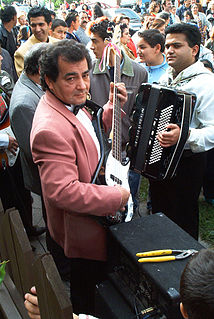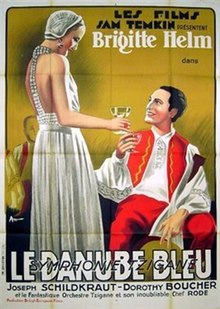
Romani music is the music of the Romani people who have their origins in northern India but today live mostly in Europe.
Brigitte Helm was a German actress, best remembered for her dual role as Maria and her double, the Maschinenmensch named Futura, in Fritz Lang's 1927 silent film Metropolis.

Joseph Schildkraut was an Austrian-American actor. He won an Oscar for his performance as Captain Alfred Dreyfus in the film The Life of Emile Zola (1937); later, he was nominated for a Golden Globe for his performance as Otto Frank in the film The Diary of Anne Frank (1959) and a Primetime Emmy for his performance as Rabbi Gottlieb in a 1962 episode of the television series Sam Benedict.

The Great Waltz is a musical conceived by Hassard Short with a book by Moss Hart and lyrics by Desmond Carter, using themes by Johann Strauss I and Johann Strauss II. It is based on a pasticcio by Erich Wolfgang Korngold and Julius Bittner called Walzer aus Wien, first performed in Vienna in 1930. The story of the musical is loosely based on the real-life feud between the older and younger Strauss, allegedly because of the father's jealousy of his son's greater talent.

The Gypsy Baron is an operetta in three acts by Johann Strauss II which premiered at the Theater an der Wien on 24 October 1885. Its German libretto by Ignaz Schnitzer is based on the unpublished 1883 story Saffi by Mór Jókai. Jokai later published a novel A cigánybáró in 1885 using an expanded version of this same story.

The Ghost Goes West is a 1935 British romantic comedy/fantasy film starring Robert Donat, Jean Parker, and Eugene Pallette, and directed by René Clair, his first English-language film. The film shows an Old World ghost dealing with American materialism.
The Romani people, also referred to as Roma, Sinti or Sindhi, or Kale, depending on the sub-group, are an Indo-Aryan ethnic group which primarily lives in Europe. The Romani may have migrated from what is the modern Indian state of Rajasthan, migrating to the northwest around 250 BCE. Their subsequent westward migration, possibly in waves, is now believed to have occurred beginning in about 500 CE. It has also been suggested that emigration from India may have taken place in the context of the raids by Mahmud of Ghazni. As these soldiers were defeated, they were moved west with their families into the Byzantine Empire. The author Ralph Lilley Turner theorised a central Indian origin of Romani followed by a migration to Northwest India as it shares a number of ancient isoglosses with Central Indo-Aryan languages in relation to realization of some sounds of Old Indo-Aryan. This is lent further credence by its sharing exactly the same pattern of northwestern languages such as Kashmiri and Shina through the adoption of oblique enclitic pronouns as person markers. The overall morphology suggests that Romani participated in some of the significant developments leading toward the emergence of New Indo-Aryan languages, thus indicating that the proto-Romani did not leave the Indian subcontinent until late in the second half of the first millennium.

Chili Bouchier was an English film actress who achieved success during the silent film era, and went on to many screen appearances with the advent of sound films, before progressing to theatre later in her career.

The Fortune Teller is an operetta in three acts written by Victor Herbert, with a libretto by Harry B. Smith. After a brief tryout in Toronto, it premiered on Broadway on September 26, 1898 at Wallack's Theatre and ran for 40 performances. Star Alice Nielsen and many of the original company travelled to London where the piece opened at the Shaftesbury Theatre on April 9, 1901, running for 88 performances. It was revived in New York on November 4, 1929 at Jolson's 59th Street Theatre and ran for 16 performances.

Souls at Sea is a 1937 American adventure film directed by Henry Hathaway and starring Gary Cooper and George Raft. Based on a story by Ted Lesser, the film is about a first mate on a slave ship who frees the slaves on the ship after a mutiny overthrows the ship's captain. The title of this film was spoofed in the Laurel and Hardy comedy film Saps at Sea (1940). The supporting cast features Frances Dee, Harry Carey, Joseph Schildkraut, Robert Cummings, George Zucco, Tully Marshall, Monte Blue, and an uncredited Alan Ladd and Edward Van Sloan.

Shalako is a 1968 British-German-American Western film directed by Edward Dmytryk and starring Sean Connery and Brigitte Bardot. It was shot at Shepperton Studios near London with sets designed by the art director Herbert Smith. Location shooting took place in Almería in southern Spain, particularly in the Tabernas Desert which was frequently used in European westerns during the decade.

The Man in the Iron Mask is a 1939 American film very loosely adapted from the last section of the 1847-1850 novel The Vicomte de Bragelonne by Alexandre Dumas, père, which is itself based on the French legend of the Man in the Iron Mask.

Herbert Sydney Wilcox CBE was a British film producer and director.

Karl Hartl was an Austrian film director.

Elizabeth of Ladymead is a 1948 British Technicolor drama film directed by Herbert Wilcox and starring Anna Neagle, Hugh Williams, Isabel Jeans and Bernard Lee. It charts the life of a British family between 1854 and 1945 and their involvement in four wars - the Crimean War, Boer War, First World War and Second World War. In each era a Beresford is in the army and dresses in the uniform of the age in most scenes, even at home.

Carnival is a 1931 British drama film directed by Herbert Wilcox and produced by his British & Dominions Film Corporation, starring Matheson Lang, Joseph Schildkraut, Kay Hammond and Chili Bouchier. During a performance of Othello a jealous actor attempts to strangle his wife who he believes has committed adultery. It was a remake of the 1921 film Carnival. The French musician Alfred Rode appears with his band.

Ernő Verebes was a Hungarian-American actor who began his career in Hungarian silent films in 1915. During his film career he worked and lived in Hungary, Germany and in the United States. He was born into a Hungarian emigrant family in New York, but his family later returned to Austria-Hungary.

Hungarian Slovak Gypsies immigrated to the United States in the late 19th century, many from Košice, Slovakia. They settled in the cities of Braddock, Homestead, Johnstown, and Uniontown, Pennsylvania; Cleveland and Youngstown, Ohio; Detroit and Delray, Michigan; Gary, Indiana; Chicago, and New York City. The Hungarian Slovak Gypsies were a community of settled Roma, and in the United States were well known for playing music for the Central European immigrant communities in which they settled. These Roma were known for playing in cafes and restaurants, the name associating these Romani as Bashaldé was made up in late 20th century, and in Hungary they are called Romungro Romani; portions of them were also known as Romungre. In the early 1900s the Roma in Braddock, Pennsylvania, purchased an entire block of homes, making them the largest population of settled Roma in the United States.
The Baroness and the Butler is a 1938 American romantic comedy film based on the play Jean by Ladislaus Bus-Fekete. Directed by Walter Lang, it stars William Powell and, in her American English-language debut, Annabella.
















